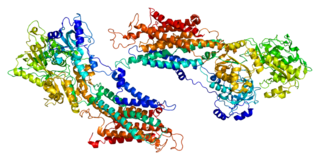Translocation protein SEC63 homolog is a protein that in humans is encoded by the SEC63 gene. [5] [6] [7]
Translocation protein SEC63 homolog is a protein that in humans is encoded by the SEC63 gene. [5] [6] [7]
The Sec61 complex is the central component of the protein translocation apparatus of the endoplasmic reticulum (ER) membrane. The protein encoded by this gene and SEC62 protein are found to be associated with ribosome-free SEC61 complex. It is speculated that Sec61-Sec62-Sec63 may perform post-translational protein translocation into the ER. The Sec61-Sec62-Sec63 complex might also perform the backward transport of ER proteins that are subject to the ubiquitin-proteasome-dependent degradation pathway. The encoded protein is an integral membrane protein located in the rough ER. [7]
Mutations of this gene have been linked with autosomal dominant polycystic liver disease. [8]

Protein ERGIC-53 also known as ER-Golgi intermediate compartment 53 kDa protein or lectin mannose-binding 1 is a protein that in humans is encoded by the LMAN1 gene.

Sarcoplasmic/endoplasmic reticulum calcium ATPase 1 (SERCA1) is an enzyme that in humans is encoded by the ATP2A1 gene.

Glucosidase 2 subunit beta is an enzyme that in humans is encoded by the PRKCSH gene.

Sarcoplasmic/endoplasmic reticulum calcium ATPase 3 is an enzyme that in humans is encoded by the ATP2A3 gene.

Protein transport protein Sec61 subunit beta is a protein that in humans is encoded by the SEC61B gene.

Selenoprotein S, also known as SELS, is a human gene.

DnaJ homolog subfamily B member 11 is a protein that in humans is encoded by the DNAJB11 gene.

Protein SEC13 homolog is a protein that in humans is encoded by the SEC13 gene.

Translocon-associated protein subunit alpha is a protein that in humans is encoded by the SSR1 gene.

Protein transport protein Sec31A is a protein that in humans is encoded by the SEC31A gene.

Ribosome-binding protein 1, also referred to as p180, is a protein that in humans is encoded by the RRBP1 gene.

Protein transport protein Sec61 subunit alpha isoform 1 is a protein that in humans is encoded by the SEC61A1 gene.

Nucleotide exchange factor SIL1 is a protein that in humans is encoded by the SIL1 gene.

BET1 homolog is a protein that in humans is encoded by the BET1 gene.

Ubiquitin-conjugating enzyme E2 J1 is a protein that in humans is encoded by the UBE2J1 gene.

DnaJ homolog subfamily C member 10 is a protein that in humans is encoded by the DNAJC10 gene.

Translocating chain-associated membrane protein 2 is a protein that in humans is encoded by the TRAM2 gene.

Vesicle-trafficking protein SEC22a is a protein that in humans is encoded by the SEC22A gene.

Translocation protein SEC62 is a protein that in humans is encoded by the SEC62 gene.

UDP-N-acetylglucosamine transferase subunit ALG14 homolog is a protein that in humans is encoded by the ALG14 gene.